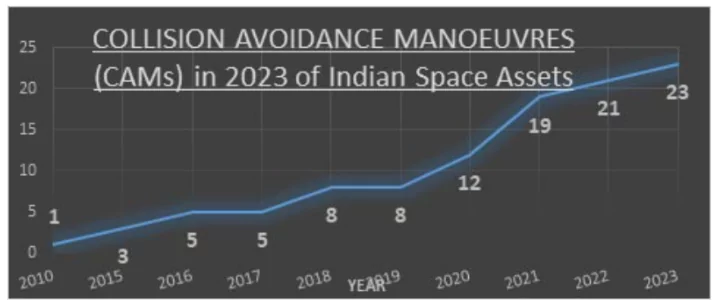Context:
The Indian Space Situational Assessment Report (ISSAR) for 2023 compiled by ISRO System for Safe and Sustainable Space Operations Management (IS4OM) has been released.
Key Highlights of Report:
Global Scenario:
- Trend of Space Object Population: It indicates a steady growth in the space object population, as reflected by the maximum number of on-orbit payload deployments with the maximum number of launches in 2023.
- This is indicative of better accessibility to space and the increasingly diverse applications of space technology in day-to-day life.
- A total of 3143 objects originating from 212 launches and on-orbit break-up events were added to the space object population in 2023 compared to 2533 objects from 179 launches in 2022.
- Need for Space Traffic Management (STM): Operating in an environment inhabited by a growing population of active satellites requires STM.
- However, unlike air and marine traffic, no universally accepted framework for STM exists at present, hence the resolution of an on-orbit close approach between two active satellites is carried out on case-by-case by inter-operator coordination.
Indian Scenario:
- Milestones in India’s Satellite Launches: Since the beginning of the Indian space era, a total of 127 Indian satellites, including those from private operators/academic institutions, have been launched till 31st December 2023.
- Indian Deep Space Missions: In addition, three Indian deep space missions were also active by the end of 2023, namely, Chandrayaan-2 Orbiter, Aditya-L1, and the Propulsion Module of Chandrayaan-3.
- Re-entry of Indian Satellites: A total of 21 Indian satellites have re-entered the atmosphere till the end of 2023. Ex- Megha-tropiques-1 underwent controlled re-entry through an immensely challenging exercise.
- Rocket Bodies: A total of 82 rocket bodies from Indian launches were placed in orbit till 2023.
- Successful launces of ISRO: In the year 2023, all seven launches of ISRO were successful.
- These included SSLV-D2/EOS7, LVM3-M3/ONEWEB_II, PSLV-C55/ TeLEOS-2, GSLV-F12 NVS-01, LVM3-M4/ Chandrayaan-3, PSLV-C56/ DS-SAR, and PSLV-C57/Aditya L-1.
Space Object Proximity Analysis (SOPA) for Satellites:

- About: ISRO regularly carries out analyses through IS4OM/ ISTRAC to predict close approaches by other space objects to Indian space assets.
- Collision Avoidance Manoeuvres (CAM): In case of any critical close approach, CAM are carried out to safeguard the operational spacecraft.
- The number of close approach alerts received and the number of CAMs executed by ISRO was also the highest to date.
Way Forward: For sustainable space activities, a holistic approach needs to be taken to catalyse the space sector growth.
- It must be recognised by all space actors that, unlike terrestrial activities, any activity in space has potentially global and far-reaching implications, and near-Earth space is a finite resource that must be utilized responsibly to harness it for societal benefits.
Additional reading: ISRO
![]() 1 May 2024
1 May 2024
